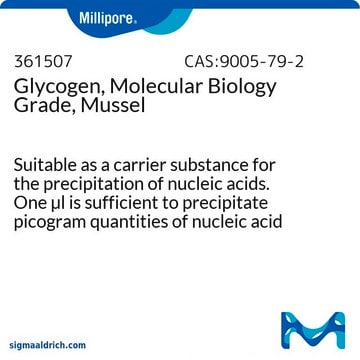G1767
Glycogen from mussel, Mytilus genus
for DNA precipitations
Synonyme(s) :
DNA and RNA precipitation
About This Item
Produits recommandés
Qualité
for molecular biology
Niveau de qualité
Forme
liquid
Conditionnement
vial of 1 mL
Concentration
19-22 mg/mL
Température de stockage
−20°C
InChI
1S/C24H42O21/c25-1-5-9(28)11(30)16(35)22(41-5)39-4-8-20(45-23-17(36)12(31)10(29)6(2-26)42-23)14(33)18(37)24(43-8)44-19-7(3-27)40-21(38)15(34)13(19)32/h5-38H,1-4H2/t5-,6-,7-,8-,9-,10-,11+,12+,13-,14-,15-,16-,17-,18-,19-,20-,21+,22+,23-,24-/m1/s1
Clé InChI
BYSGBSNPRWKUQH-UJDJLXLFSA-N
Vous recherchez des produits similaires ? Visite Guide de comparaison des produits
Catégories apparentées
Description générale
Application
- as a coprecipitant in the isolation of RNA from hepatocytes and yeast cells.
- as a reference standard in calibration curve generation to quantify hepatic glycogen content.
- as a carrier molecule for DNA and RNA, replacing tRNA or sonicated DNA
- for the precipitation of DNA in the presence of ammonium acetate and ethanol or isopropanol
- for recovery of tRNA, yeast RNA, sonicated DNA and oligonucleotides as short as 8 base pairs
Actions biochimiques/physiologiques
Caractéristiques et avantages
- product provided is 1 mL total volume
- precipitates even small amounts of DNA and RNA present in dilute solutions
- does not interfere with OD 260/280 readings
Principe
Produit(s) apparenté(s)
Code de la classe de stockage
11 - Combustible Solids
Classe de danger pour l'eau (WGK)
WGK 3
Point d'éclair (°F)
Not applicable
Point d'éclair (°C)
Not applicable
Équipement de protection individuelle
Eyeshields, Gloves, type N95 (US)
Certificats d'analyse (COA)
Recherchez un Certificats d'analyse (COA) en saisissant le numéro de lot du produit. Les numéros de lot figurent sur l'étiquette du produit après les mots "Lot" ou "Batch".
Déjà en possession de ce produit ?
Retrouvez la documentation relative aux produits que vous avez récemment achetés dans la Bibliothèque de documents.
Les clients ont également consulté
Notre équipe de scientifiques dispose d'une expérience dans tous les secteurs de la recherche, notamment en sciences de la vie, science des matériaux, synthèse chimique, chromatographie, analyse et dans de nombreux autres domaines..
Contacter notre Service technique












